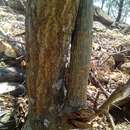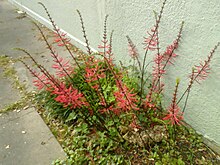en
names in breadcrumbs


Erythrina americana ye una especie de árbol perteneciente a la familia Fabaceae.
Ye un árbol pequeñu qu'algama un tamañu de 3 a 6 m d'altor, de cañes espinoses. Les fueyes tán estremaes, son de color verde maciu y tien grupos de flores coloraes allargaes dispuestes en recímanos piramidales. Los frutos son vaines estruyíes, les granes de color coloráu escarlata con una llinia negra.
Orixinariu de Méxicu, comúnmente llamáu Colorín. Planta cultivada en güertos familiares o cortiles, cerca de ríos o terrenes de vega o de cultivos abandonaos, acomuñada al monte tropical caducifoliu y carba xerófilu.
Les partes aérees de les especies del xéneru Erythrina pueden contener alcaloides, tales como la eritralina y la erisodina, que la so ingestión puede suponer un riesgu pa la salú.[1]
Erythrina americana describióse por Philip Miller y espublizóse en The Gardeners Dictionary: . . . eighth edition non. 5. 1768.[2]
Erythrina: nome xenéricu que provién del griegu ερυθρóς (erythros) = "coloráu", en referencia a los color coloráu intensu de les flores de delles especies representatives.[3]
americana: epítetu xeográficu qu'alude al so localización n'América.
Pulgu de chomplantle, chocolín, colorín, colorín grande, equimite, gasparito, pemuche, pichoco, piñón espinosu, quimite.
 Esta páxina forma parte del wikiproyeutu Botánica, un esfuerciu collaborativu col fin d'ameyorar y organizar tolos conteníos rellacionaos con esti tema. Visita la páxina d'alderique del proyeutu pa collaborar y facer entrugues o suxerencies.
Esta páxina forma parte del wikiproyeutu Botánica, un esfuerciu collaborativu col fin d'ameyorar y organizar tolos conteníos rellacionaos con esti tema. Visita la páxina d'alderique del proyeutu pa collaborar y facer entrugues o suxerencies. Erythrina americana ye una especie de árbol perteneciente a la familia Fabaceae.
Tzompancuahuitl ahnozo equimitl (caxtillāntlahtōlli: Colorín).
Erythrina america (coral tree, colorines, colorín, or pemoches), is a flowering plant of the genus Erythrina which is native to Mexico. Colorín (plural colorines) is the name of a type of tree, Erythrina americana also called Tzompāmitl. The word colorín means color chillón—a “gaudy” or “loud” color (Williams 1959).
Colorines plant also called, cuchillitos (little knives) or machetitos (little machetes), zompantle, or coral is a nice flower, red in color and every individual flower resembles a little machete, the flower is edible[2] and is boiled (only the red part of the flower) and cooked with scrambled eggs or tuna in many parts of south Mexico.
This variety flowers during the dry season (April) in many parts, and the plant is very popular with hummingbirds because of the bright red color, the plant ranges from a few feet off the ground to trees five meters tall.
The earliest depiction of this tree in America is in the Florentine Codex. In the 17th century, Francisco Hernández commented: "The juice from the flowers of this tree, given to children induces drowsiness and sleepless".[3]
Other sites explain that although the flower is edible,[4] the seeds and everything else in the tree is highly toxic, in Mexico, the grounded seeds are used as rat poison and the bark is used as fish poison.[5]
E. americana is a tree that grows to 4-5m. It has pale, brown, smooth bark and a spreading and profusely branching crown. It sheds its leaves during winter and the dry season. Leaves are . It has sprines on the branches and conical, flat spines on the trunk. Leaves are arranged alternately and are trifoliate with rhombic-ovate leaflets that are 7-22cm long and broad.[6]
The flower is edible, This tree is very popular with kids who use the flowers as a little knives to stab each other. The ground seeds and bark are used as poison, The tree is also used to make traditional crafts in many Mexican states, specially traditional dance masks[4] and is also used as fence post in many parts of Veracruz Mexico, it is a beautiful and hardy tree, some varieties even tolerate frost.
The tall varieties of this plant are rarely used as a garden plant, but the dwarf varieties are used as garden plants because they tolerate frost, they tolerate heat and come from dry places, and they flower early and attract hummingbirds.
Erythrina america (coral tree, colorines, colorín, or pemoches), is a flowering plant of the genus Erythrina which is native to Mexico. Colorín (plural colorines) is the name of a type of tree, Erythrina americana also called Tzompāmitl. The word colorín means color chillón—a “gaudy” or “loud” color (Williams 1959).
Colorines plant also called, cuchillitos (little knives) or machetitos (little machetes), zompantle, or coral is a nice flower, red in color and every individual flower resembles a little machete, the flower is edible and is boiled (only the red part of the flower) and cooked with scrambled eggs or tuna in many parts of south Mexico.
 Colorines, machetitos machete Erythrina americana plant from Texas
Colorines, machetitos machete Erythrina americana plant from Texas This variety flowers during the dry season (April) in many parts, and the plant is very popular with hummingbirds because of the bright red color, the plant ranges from a few feet off the ground to trees five meters tall.
The earliest depiction of this tree in America is in the Florentine Codex. In the 17th century, Francisco Hernández commented: "The juice from the flowers of this tree, given to children induces drowsiness and sleepless".
Other sites explain that although the flower is edible, the seeds and everything else in the tree is highly toxic, in Mexico, the grounded seeds are used as rat poison and the bark is used as fish poison.
El zumpantle (Erythrina americana[1]) es un árbol de planta de la familia Fabaceae de hasta 10m de alto. Su corteza es rugosa corchosa amarillenta armada con espinas. Hojas grandes con tres folíolos glabros, deltoides, el central más grande que los laterales.Flores tubulares rojas en racimos. Pedicelo pubescente. El fruto es una vaina coriácea negruzca, abre al madurar y permanece con semillas rojas muy vistosas. Es originario de América, de regiones tropicales y subtropicales. Su distribución es incierta debido a su amplio cultivo prehispánico. Se usa como árbol de sombra y de ornato. Las flores son comestibles hervidas y siendo limpiadas con anterioridad, se remueve los estambres dentro de esta planta, también conocida como garra de dragón. Tiene varios compuestos tóxicos.[2]
Árboles de Cuernavaca
Es un árbol pequeño que alcanza un tamaño de 3 a 6 m de altura, de ramas espinosas. Las hojas están divididas, son de color verde pálido y tiene grupos de flores rojas alargadas dispuestas en racimos piramidales. Los frutos son vainas comprimidas, las semillas de color rojo escarlata con una línea negra.
Originario de México, comúnmente llamado Colorín. Planta cultivada en huertos familiares o solares, cerca de ríos o terrenos de vega o de cultivos abandonados, asociada al bosque tropical caducifolio y matorral xerófilo.
Las partes aéreas de las especies del género Erythrina pueden contener alcaloides, tales como la eritralina y la erisodina, cuya ingestión puede suponer un riesgo para la salud.[3]
Erythrina americana fue descrita por Philip Miller y publicado en The Gardeners Dictionary: . . . eighth edition no. 5. 1768.[4]
Erythrina: nombre genérico que proviene del griego ερυθρóς (erythros) = "rojo", en referencia al color rojo intenso de las flores de algunas especies representativas.[5]
americana: epíteto geográfico que alude a su localización en América.
Cáscara de chomplantle, chocolín, colorín, colorín grande, equimite, gasparito, pemuche, pichoco, piñón espinoso, quimite.
El zumpantle (Erythrina americana) es un árbol de planta de la familia Fabaceae de hasta 10m de alto. Su corteza es rugosa corchosa amarillenta armada con espinas. Hojas grandes con tres folíolos glabros, deltoides, el central más grande que los laterales.Flores tubulares rojas en racimos. Pedicelo pubescente. El fruto es una vaina coriácea negruzca, abre al madurar y permanece con semillas rojas muy vistosas. Es originario de América, de regiones tropicales y subtropicales. Su distribución es incierta debido a su amplio cultivo prehispánico. Se usa como árbol de sombra y de ornato. Las flores son comestibles hervidas y siendo limpiadas con anterioridad, se remueve los estambres dentro de esta planta, también conocida como garra de dragón. Tiene varios compuestos tóxicos.
Árboles de Cuernavaca
Erythrina americana là một loài thực vật có hoa trong họ Đậu. Loài này được Mill. miêu tả khoa học đầu tiên.[1]
Erythrina americana là một loài thực vật có hoa trong họ Đậu. Loài này được Mill. miêu tả khoa học đầu tiên.